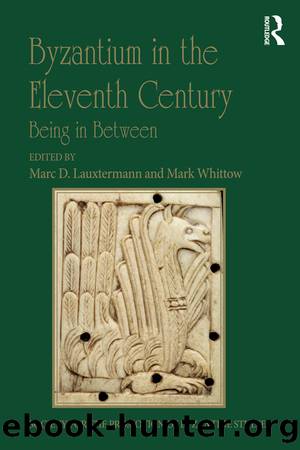Byzantium in the Eleventh Century by Marc D. Lauxtermann;Mark Whittow;

Author:Marc D. Lauxtermann;Mark Whittow;
Language: eng
Format: epub
Publisher: Taylor & Francis (CAM)
Published: 2017-08-15T00:00:00+00:00
9
Storm Clouds and a Thunderclap
East–west tensions towards the mid-eleventh century
Jonathan Shepard
The outlines of the ‘storm clouds’ under discussion will be as familiar to modern observers as are some of the ‘weather systems’ to which they belong. They involve the quickening of long-distance trading and written communications in the course of the long eleventh century (c.950–c.1100);1 ever more frequent face-to-face encounters of western Christians with easterners and Muslims and also, in Scandinavia and Rus, with pagans; the Byzantine commonwealth’s extension to virtually its fullest extent, while Latin ecclesiastical organization spread north and east; and the quest among western churchmen for clear-cut, canonical, authorities, at a time when the German emperors’ material power and sense of divine mandate was hardening: a quest for precision articulated in the Investiture Contest with the emperor.
The significance and even the existence of some of these developments have become controversial in recent years. The very concepts of the Byzantine Commonwealth and the Investiture Contest are open to question,2 while the so-called Church Schism runs up against abundant evidence of amicable exchanges and cooperation between the Byzantine government, the papacy, and western political leaders long after 1054. Religious ‘orthodoxy’ itself now appears more labile than previously supposed, with the ‘thunderclap’ of excommunications between Michael Keroularios and the papal legates liable to relegation to the level of a freak storm, virtually a ‘non-event’.3 Our aim is neither to try to restore to 1054 the status of a turning point in east–west relations nor to track down some other event or set of polemics that might be said to have changed the situation irrevocably. Our concern is, rather, with the contradictory tendencies that were in play in a period of rapid socioeconomic growth, proliferating resource centres, expanding functional literacy in many parts of Europe and, in some Lotharingian, northern French and north Italian cathedral schools, intellectual training that went far beyond the copying of, and commentaries on, texts to close analysis of terminology, with ever higher expectations of precision and clarification of the meaning of rites and symbols.4
These stirrings are most evident in western Europe, but there are hints of comparable phenomena in Byzantium, too.5 And they could be seen as part of a general tendency towards Christian convergence, encompassing the Mediterranean world and indeed all Europe, as cults, texts and concepts circulated more freely together with persons and commodities. However, they could also foster a certain impatience with the status quo and a quest for rectification of long-held errors and malpractices, in pursuit of a superior moral order and in accordance with more stringent rules and clear-cut imperial or ecclesiological authority. Such tendencies towards the stricter demarcation of boundaries and norms just at a time when alternatives and variants become readily available have received elucidation from Frederic Barth; and I have myself attempted to characterize the long eleventh century as an era of ‘convergence and collision’, when physical barriers were lowered, only for new limitations and exclusions to be imposed by human agency.6 What follows will point out some
Download
This site does not store any files on its server. We only index and link to content provided by other sites. Please contact the content providers to delete copyright contents if any and email us, we'll remove relevant links or contents immediately.
| Africa | Americas |
| Arctic & Antarctica | Asia |
| Australia & Oceania | Europe |
| Middle East | Russia |
| United States | World |
| Ancient Civilizations | Military |
| Historical Study & Educational Resources |
The Battle of Mogadishu by Matt Eversmann & Dan Schilling(698)
The Confidence Men by Margalit Fox(650)
The Spymaster of Baghdad by Margaret Coker(620)
A History of the Muslim World since 1260: The Making of a Global Community by Vernon O. Egger(616)
Jack the Ripper and the East End by Peter Ackroyd(583)
Empire of Fear: Inside the Islamic State by Andrew Hosken(564)
The Afghanistan File by Prince Turki AlFaisal Al Saud(549)
The Crimean War by Winfried Baumgart(544)
Akhenaten by Dominic Montserrat(535)
The Jerusalem Diamond by Noah Gordon(531)
Islam At The Gates: How Christendom Defeated the Ottoman Turks by Diane Moczar(530)
A Concise History of Greece (Cambridge Concise Histories) by Richard Clogg(527)
The History of Jihad by Robert Spencer(526)
Beirut 2020 by Charif Majdalani(514)
Israel: Ancient Kingdom or Late Invention? by Daniel I. Block(512)
Enemy in the East by Rolf-Dieter Müller(509)
The Privatization of Israeli Security by Shir Hever(500)
Destroying a Nation: The Civil War in Syria by Nikolaos van Dam(493)
The Nine Lives of Pakistan by Declan WALSH(490)
